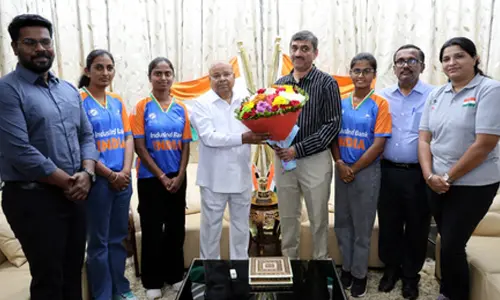Go slow on ban of single use plastic

Official ban on ‘single use plastic’ of 50 microns (0.005cms) and below came into effect from October 2, 2019 and complete eradication is slated for 2022.
Official ban on 'single use plastic' of 50 microns (0.005cms) and below came into effect from October 2, 2019 and complete eradication is slated for 2022.
The chief reason is, the sachets of lengths and breadth of 8 inches and 6 inches clog water drains, eyesore to see on streets, highways, parks, schools and public premises. Since non-biodegradable, it ever remains on our soil.
The degraded micro-plastic is even found in marine fish, whales etc., a cause for international concern. Indeed, in India, hungry cows eat these plastic sachets, due to which many of them died.
Let's look at the positive side of plastic use: Some three decades ago, kirana shops (grocery stores) and even super bazaars used to sell rice, dals (lentils), flour etc., loose, weighed in our presence and packed in paper.
Later milk, oil, and PET water bottles and drinking water pouches came into use. During those days all grocery items in kirana shops were exposed to dust and dirt during the daytime, during nights rats, cockroaches had their way, profusely ate those items.
Rat urine and excreta contaminated food items, an extremely dangerous health hazard. Oils sold from a tin container have every chance of some insects creeping in it.
One will always have doubt about the milk sold in glass bottles, if the bottles are properly cleaned. Most importantly, many water-borne diseases considerably diminished after introduction of mineral water in PET or pouches.
To have water was always difficult during train travel, to fill water in glass bottles during a few minutes of halt at railway stations. The water available at railway stations were always untreated borewell water and most of the time the taps were non-functional.
Thus, the fear of contamination, adulteration, hygiene, of all our food items and water was always a matter of worry at that time. Hotel servers supplying water in glasses with fingers dipped, was always a nightmare.
All over our country, the plastic sachets of food items are now available. At least the products from packing stage at godown to consumer level are now safe.
Plastic does not exude any toxic chemicals, or vapours, and are non-carcinogenic. The same food products are sold in plastic sachets, the same brand, whether in super bazaar or roadside kirana shops.
Turning to children's snacks and potato chips and such eatables, although we call it junk food, packed in sachets made up of Aluminium laminated polymers are hygienic. Previously, some 20 years back, children used to eat snacks swarmed by flies, dust and dirt.
We have now cement, fertilisers, urea and rice in waterproof plastic-coated bags, instead moisture sensitive jute bags, are safe for transport.
Anyway, we have not enough jute to meet our needs.
In fact, use of plastic changed our way of life, gave us "health security". The chief complaint about plastic is we are insensitive to environment and throw the empty bags anywhere.
One prime reason is the governments and municipalities did not make sufficient arrangements to segregate solid plastic from mostly food residues while putting into dust bin. In fact, we believe no Indian town or city have such arrangement.
If we ban these plastic items, the strain on paper industry, to manufacture hard paper sachets, will be much more. The result is we have to convert valuable agricultural lands to raise Subabul and Eucalyptus.
After cuttings these trees, the land will be 'treeless' devoid of greenery for at least three years. This will defeat our "forestry green programme". Plastic also reduced the strain on our forests, to supply wood for furniture also.
There are no two opinions that plastic consumption should be limited. Our waste management use has many options: Instead of throwing into dust bin these sachets can be stored inhouse and can be put into box, like post-box at the street end, to be sent for re-cycling.
It can be exchanged for another product in shop if the government seriously makes some moves in that direction. Recycling is one arrangement, but soon, after recycling, it makes appearance in the market again.
On YouTube, one may find many methods to transform them into another useful product like pillows etc., Many patents are found on internet, like polyethylene and polystyrene (used chiefly for packing goods like refrigerators and false ceilings) dissolve well in organic solvent, could be mixed with cement before use, to make construction strong.
Of course, incineration is the best option, but we may not have technology to neutralise toxic gases. At the moment, finely shredded plastic seems to be mixed cement. Tar or cement mixed plastic powder may have wider application in road laying.
Where plastic could be avoided like carry bags, we should use cloth bags for such purposes. Indians in general are thrifty, they keep attracted towards coloured plastic bags for packing new clothes.
We see on roadsides, choking drains by small size 6 inches to 8 inches plastic bags. Bigger plastic bags used for cement etc., will be preserved by us.
Ban or reduce plastic use is a mandate for world countries, already adopted by many small countries of Africa. Of particular international concern including USA and Europe is, the plastic waste dumps found in sea floating, the consumption of micro plastic particles (microscopic particles of the plastic size of 4.5 mm, naturally shredded by ocean currents) consumed by fish, whales etc., which suffer mortality.
The plastic debris settled on marine bed also threatens marine life. Approximately eight million tonnes of plastic is found its way into sea, described as giant "Pacific Plastic Dump".
Its size is bigger than the size of France, Germany and Spain combined and also such dump exists at Hawaii island and California, according to a study published in the Journal "Scientific Reports". There is a danger of consumption of such marine food which may enter into our food chain, indeed a health hazard.
Biodegradable plastic which involves use of many plant products, gums, paper seaweeds, algae, is not feasible at the moment to replace plastic.
At the end, the strong suggestion is not to ban 200 ml water pouches if they made above 50 microns (0.005cm). It is poor man's drinking water at the work site who cannot buy Rs 20 or Rs 24 water bottle.
It is wise to concentrate on waste management of plastic rather than outright ban right now. We shall also watch and adopt how these concerns addressed by US, EU.
(Dr K Nagaiah is Chief Scientist, CSIR-IICT, Hyderabad and
Prof G Srimannarayana is retired Professor, Department of Chemistry, Osmania University, Hyderabad)














